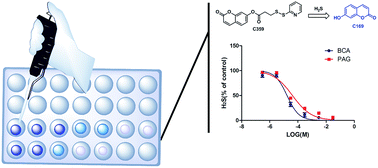Development of a highly selective H2S fluorescent probe and its application to evaluate CSE inhibitors†
Abstract
In this paper, we developed a novel fluorescent probe C359 for highly selective detection of H2S over other relevant biothiols. C359 is designed to contain a thiol-specific cleavable disulfide bond. H2S-mediated the disulfide cleavage and subsequent intramolecular cyclization released the masked 7-hydroxyl coumarin, displaying a remarkable fluorescence enhancement. With the promising features in hand, C359 has been applied to detect the activity of CSE (one of H2S-producing enzyme) and build up an assay for screening CSE inhibitors. We anticipated that the enzyme assay using C359 could provide a powerful methodology for screening more potent and selective enzyme inhibitors.


 Please wait while we load your content...
Please wait while we load your content...